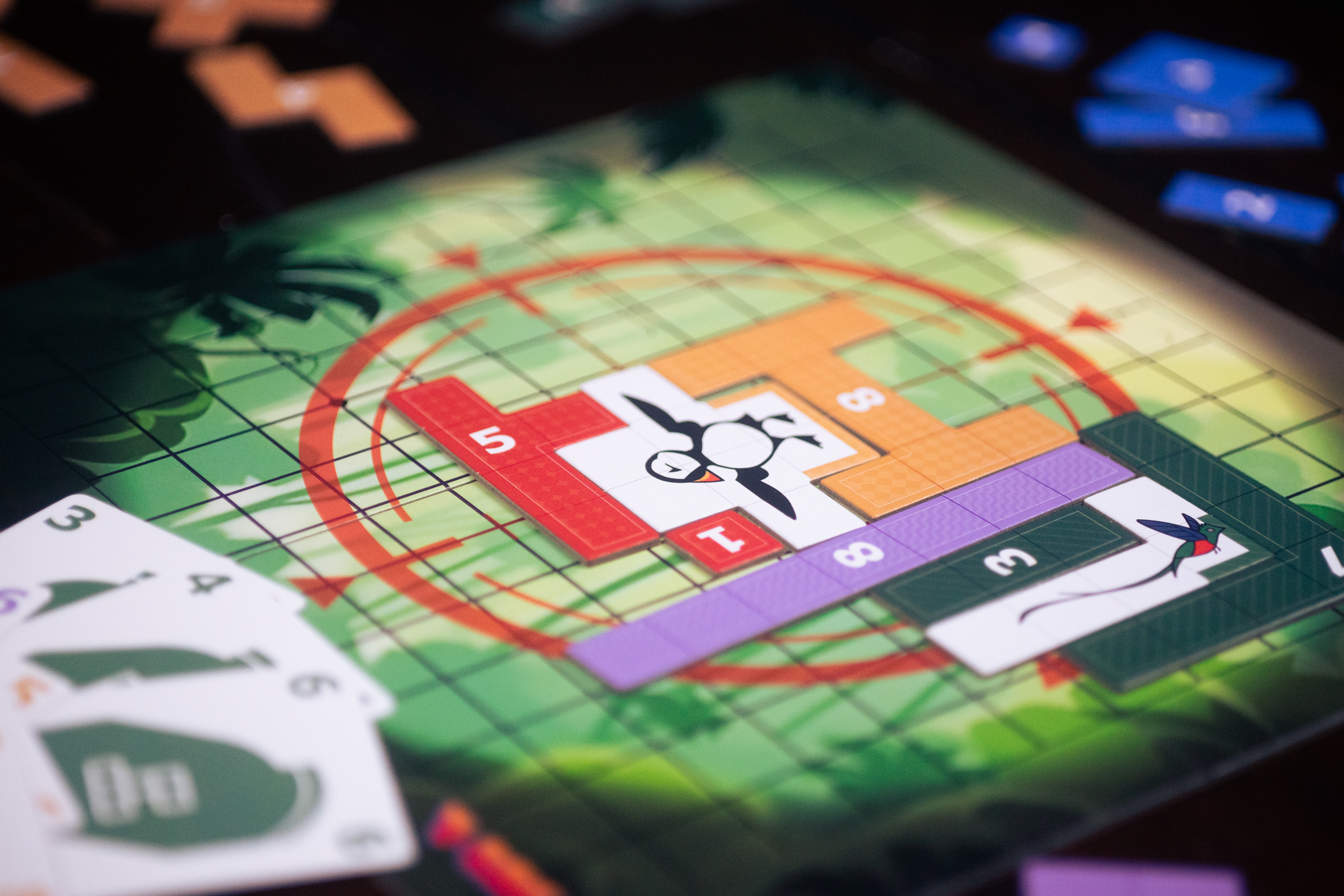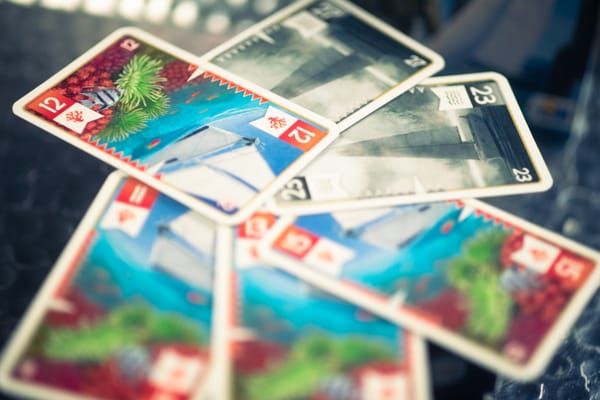The 24 trick-taking games I played in one weekend
TTUTCON II introduced me to so many amazing games.

One of my favorite things in 2024 was attending TTUTCON: The Trick-Takers of Utah Convention. It’s a board game convention focused squarely on trick-taking games. When the organizers of the event announced they’d be putting TTUTCON II together, I couldn’t wait to attend, and life found a way for me to be there.
Over the course of the two days of the convention — and one day before it started — I played 24 different trick-taking games. I know that number is slightly smaller than last year’s count (25!), but I did play Crisps! six times throughout the convention, so I think that makes up for any potential lost ground.
Here are those 24 games. I’ve written far too much about this, so you’ll have to accept a small apology from me. Sorry. I didn’t mean to write so much. I know this is more than last year, even though I played one fewer game. All I can be is sorry, and sorry is all that I am.
Alright, well, let’s not waste time. Here we go!

Day one: TTUTCON II kicks off
The Bottle Imp (Cornett, 1995) started off my convention-going in good fashion, as it’s one of those ‘great-with-three’ trick-takers, and I was playing with two others — Dave, who I met in 2024 at the inaugural TTUCON, and his friend Rick. It’s a brutal little game based on Robert Louis Stevenson’s story of the same name. This is a must-follow game, and the winner of the trick is the one who plays the highest card ranked lower a central card (the “hell card”), or when no player has played lower, the player with the highest-ranked card. The whole game hinges on being able to shed your low cards without consequence, but somebody always gets stuck holding the bottle, and it’ll be painful — after all, they’ll lose a bunch of points. We played the 2024 edition of the game, which is technically a new version, but the base rules are basically the same. I dunno. Designed by Günter Cornett, illustrated (in the 2024 edition) by Maxime Morin, and published by Grail Games.
Bid Coin (Shibu, 2024) is a cool little trick-taker in which you’re aiming to be the first player to successfully meet your bids, which are represented by coin cards. You’ll start with 1, 2, 3, 5, and 7 coin cards, which means you’ll have to win at least 18 tricks across the course of the game, but there’s a big caveat here: You have to declare the number of tricks you’re going to win each round with those cards, and once you’ve met a bid with a card, it goes away. As an example, if you’ve decided you’ll aim to win six tricks in a round, you might offer up the 5 and 1 cards, or maybe you’ll instead offer up the 1, 2 and 3 cards. Unusually, you get to adjust your bid any time you exceed it, so there’s always a chance you’ll be able to adjust — but once those cards are gone, there’s no getting them back, and if you overshoot by two tricks won, and the 2 card is gone, you might just be up a creek. This was a really clever game. Designed by Shibu, illustrated by Natsuki Okada, and published by Korokorodou.
Extreme Tricks (Uesugi, 2023) is a trick-taking game about skateboarding, and I’m not sure there are enough of those out there. (This one’s due for a reprint by Allplay as Sick Tricks — perhaps an even better name.) It made its debut as a print-and-play game, which on its own is already pretty unusual for a trick-taking game — but there’s a reason this game is getting a wider release, and that’s because it’s got some really cool ideas. Basically, before each round, you’re confronted with a series of predictions — tricks you’re going to try to land. You’ll decide how many of those predictions (which really are just bids on specific goals) you think you’ll be able to accomplish. You’ll mark half of the tricks you think you’ll accomplish, and you’ll hold in reserve markers for the other half. The predictions you mark initially and complete will net you two points, and you’ll lose one point if you don’t complete it. But the remaining predictions can still be completed, and that’s where the game gets wild: You’ll need to plan carefully, because if you complete a prediction and you’re out of markers, you’ll lose two points. Ah! Fun stuff. Masato Uesugi may be best known for the broadly successful Welcome to the Dungeon (2013), and I’m excited for this one to reach a wide audience, too. Designed by Masato Uesugi and published (sort of) by I Was Game.
Fishing (Friese, 2024) is probably my game of the convention. I hadn’t played it, in part because I was a bit worried about the complexity for novice trick-takers. I think that worry might have been overblown, but I also sort of think I made the right call? I don’t know. Let’s talk. Fishing is a wild little game. You start with a hand of cards. Nothing unusual there. After each round, though, you’ll have won some tricks (maybe!), and that’ll become your new hand. There’s a problem, though. You’re going to run out of cards. Fast. See, if you don’t win enough tricks, you won’t have enough cards to play a round. And if you win too many, you’ll have too many. The solution? A brand new deck of cards, which are organized in such a way as to get increasingly powerful as you make your way through the deck. The game plays over a bunch of rounds, and while I don’t remember how many rounds we played, it was a lot. You’re incentivized to lose tricks with great frequency, and I love that. It’s not a trick-avoidance game — you’re still going to lose out on points if you don’t take tricks — but losing tricks has never been so much fun. Every time I lost a trick, I was excited. I probably was too aggressive there, but you know what? I had fun. One of the fascinating things here is that the trump suit doesn’t even start in players’ hands — it’s in that deck of cards from which you’ll be fishing. Designed by Friedemann Friese, illustrated by Maren Roche, and published by Rio Grande Games in the United States and 2F-Spiele in most other markets.
LetterTricks (Wray, 2021) is a game designed by Chris Wray (who I’m lucky to call a friend and to have played games with at TTUTCONs I and II), and it’s the first in his series of self-published games that culminated with Kansas City: The Trick-Taking Game (2024). It’s a must-follow trick-taker in which you’re collecting cards with which you’ll spell words at the end of the round — so if you don’t collect letters, you won’t be able to spell a word and thus score points. Having played this one at 4 players, I’m actually more curious about the three-player rules, as well as the cooperative rules, all of which use the same game. That’s one thing Chris does so well: His games so often come with several well-crafted ideas, each of which is a different experience in its own right. Perhaps more recently he’s narrowed down the scope and gone with an expansion, as with Rewind (2024) and Rewind: Tricks in My Mind, and even Kansas City with The Tricks and Trains Expansion (2025). Even his published game Xylotar (2024) ended up with an expansion, Xylotar: Unhinged (2025). This guy’s just full of great ideas, and I’m lucky enough to have spent time with him at TTUTCON both years. Designed and self-published by Chris Wray, and illustrated by Megan Russell.

Oracle (Dorra, 2020) is a trick-taking game in which you’ll have two goal cards each round (selected from eight with which you start) which will grant you points based on some condition. Each time you take a trick, you’ll take a token corresponding to a mythical animal you’ve won the trick with, and those animals aren’t tied to suit but rather to the rank of the card. But if you take too many tricks of one animal type, you might end up with the dreaded ‘loser chip,’ which nullifies any matching mythical animal scoring tokens you’ve taken at the end of the round. Playing this one right after Stefan Dorra’s much more exciting Skull Queen was perhaps not the wisest maneuver, as Oracle felt a bit more focused and concentrated than his more recent effort. Designed by Stefan Dorra, illustrated by Christian Opperer, and published by Skellig Games.
Skull Queen (Dorra, 2024) is a chaotic trick-taker that bears no relation or resemblance to Skull King (Beck and Beck, 2013). Let’s get that out of the way first. Don’t expect Skull King: The Sequel here, because it’s not that at all. No, this is a trick-taker designed by one of the great European designers, and while it’s chaotic, there’s some really thoughtful design happening here. In each round, you’re going to essentially bid on the number of tricks you think you’ll win in each of four suits, and you’ll do that by placing each of them on a little cardboard plank at one of five positions. It’s double-sided, so at one end is a low-value prediction, and at the other is a high-value prediction. As you win tricks, you’ll advance or retreat a token based on the suit you play, and if you advance off the plank or retreat back to the ship, you’ll lose bidding on that suit completely. There’s a tiny bit more nuance, but not a ton: This is a game that revels in its chaos, that pits players against each other. Designed by Stefan Dorra, illustrated by Cinthya Álvarez, and published by Schmidt Spiele.
Crisps! (Bhat, 2025) is a great two-player climbing game in which you’re playing sets and runs from an unsuited deck. After each trick, both players will take a new card and add it to their hand; the winner will choose between a face-up and face-down card, while the loser will receive the remaining card. I played in a reasonably large tournament — I think half the con’s attendees took part — and somehow, someway managed to come away champion. Each game took the classic best-of-five approach, and in each game I played, it took the full five rounds to advance. It made for a really nice con experience, and I’m still a little surprised I won. Maybe those BGA Crisps tournaments paid off? Designed by Shreesh Bhat, illustrated by Sai Beppu, and published by Little Dog Games.
Spring Cleaning (Cox, 2024) is a climbing/shedding game in the “don’t reorganize your hand” style, which I honestly think is still a great time, despite it no longer being strictly novel. In this one, you can play melds that consist of one more card than the active meld, and you can do it — importantly — with the help of one or more cards from around the table in players’ “offers.” See, the game’s themed around spring cleaning, which means you’re going to get rid of a bunch of stuff. This is something in real life I’m not particularly good at, but I think I do alright in this game. When you have to pass, you’ll add to your offer, and when you’re out of cards, you’ll take any offer cards remaining and put them into your hand. It’s clever, unusual, and such a good time. This is actually getting a reimplementation as Haunted Mouse, which is A) an incredible name, and B) a bit of a funny retheme. I’m excited that it’s coming from Bezier Games, though, because this game absolutely deserves more attention that it’s received from its short-run publication. Designed and illustrated by Jonathan Cox and published by Little Dog Games.
Trickarus (Cannon, 2024) is a game that takes the story of Icarus — the guy who flew too close to the sun, resulting in his plummeting to earth after the wax holding his wings melted. I think that’s right, at least. The basic idea here is that if you win too many tricks, you’ll plummet back below the other players, having to climb back up above other players if you want to win. But here’s where it gets tough: The game ends in the round in which a player has first flown into the sun. And while you might think, “alright, winning ten tricks seems like a tall order,” you don’t have to win that many tricks. If you win a trick, you leap (fly?) over other players, so if you’re at the 1 mark with three players directly in front of you, then win a trick, you’ll end up at the 5 mark. And suddenly, everything seems a little more risky. It’s a really cool little game. Designed by Bajir Cannon and published by Learn Bridge Online.

Day two
1 A.M. Jailbreak is a lightweight climber in which the cards are unsuited and the ranks of cards only barely matter: You’re just trying to play a ton of cards, which is admittedly a fun thing to do. You’ll either play runs or sets, and if you’re following, you can either play between one fewer and one more card than the previous player. It’s a real twist with a climber that you can go backward, and that really did make it a unique experience. This one was a bit weird, but it was fast, and I think there’s an interesting design in here. Designed by Saashi, illustrated by Takako Takarai, and published by Shashi & Shashi.
Bacon (Ross, 2024) closed out the convention for six of us, and it remains undefeated as the greatest climbing game at the unusual six-player count mark. It’s really just a perfect partnership game, and it all hinges on two Bacon cards with which each player starts. Those cards are wild, and they can be used to make both combinations and specials — or, if you will, bombs. That provides not just uncertainty with what other players can do, but it provides a near-certainty that your opponents will be able to do something to counter your play. Add in three-player teams and the ability to pass play when you win a trick to one of your two teammates, and you’ve got a game that’s just unusually fun. (You can definitely play this with fewer than 6, but that’s really where it shines.) Designed by Sean Ross, illustrated by William Harris, and published by Allplay.
Egyptricks (Wray, 2025) is a game designed specifically for TTUCON II by Chris Wray, who I interviewed about independent game publishing earlier this year. Egyptricks is a three-player game that’s a bit of a spin on his game Rewind (2024), in which players are playing tricks over two rounds with the same hand of cards. This also includes the card’s suit on card backs to give the game a real ‘low-luck’ feel, which Chris described in the rules as one of the goals of the design. It sounds like this might make its way as a Rewind expansion, which is excellent news indeed. This is especially clever because it’s focused so tightly on three-player play: One player wins the trick and thus points, the second-placed player wins the opportunity to earn points in the second round, and the player with the lowest card gets to manipulate the second round (or occasionally the first) in some meaningful way. Designed and self-published by Chris Wray, and illustrated by Megan Russell.
Gachapon Trick (Newman, 2024) is a trick-taker with a little bit of toy-based gambling. You know those gachapon machines they have in Japan? This game puts you in front of one constantly. It’s a set collection and trick-taking game, and you’ll earn more points for larger collections of the same toy. Each turn, everyone will play a toy to the trick — it’s a must-follow trick-taker, so that’s not complicated — and if you win the trick, you’ll get to buy one or more from the trick. And that’s cool, but the best part is that each time you win a trick, you can also buy from the gachapon machine. You have no idea what you’ll get, but it might be exactly what you’re looking for — or, more often, it won’t even be close. This remains one of my favorite little trick-takers to bring around, because it’s just so fun to test your luck. Designed by Daniel Newman, illustrated by Sai Beppu, and published by New Mill Industries.
Le Plateau (Brown and Gallardo, 2021) featured again this year, as it’s just an incredible game to play with experienced players. It’s a trick-taking game played with a French tarot deck and a hexagonal board, each cell of which features either a trick number (there are 13 tricks played in a round at five players) or a card. One player, potentially with a partner, will try to form a connection from one end of the board to another, filling in spaces depending on the cards you win in tricks or the trick number. To start each round, you’ll take turns bidding for the number of sides of the board you can connect, either with or without a partner, depending on your bid. The trick play is normal, but every trick feels high-stakes, especially as the paths for forming connections narrows. It’s an incredible game, and it feels like just the thing to play at a trick-taking convention. I think I flubbed more rounds of this than I really should have, but it was great, and I played with nearly the same group as last year. Magical. Designed by Dr. Steven Brown and Raymond Gallardo, published by BrownCastle Games.
Mü (Matthäus and Nestel, 1995) is one of the early non-traditional partnership trick-takers, and while it holds up really well, it lacks a little bit of the flash of some modern trick-takers. It more than makes up for it with one of the greatest bidding systems: You’re bidding with cards from your hand during a bidding phase to take the role of Chief, and the number of cards you bid decides how many points you need to win, as well as the bonus points you’ll earn if you’re successful (or will lose if you’re not, which is a fact I became well-acquainted with.) This is the sort of game that I’d need to play dozens of times to write about effectively. It’s more multifaceted than most trick-takers, and the bidding itself could be its own game. This is another game that playing with experienced trick-takers really made the experience all the more rich.
No Loose Ends (Shinzawa, 2025) is a reimplementation of 2024’s Shut the Books from the great Taiki Shinzawa, and while I think I’d prefer a book theme to a heist theme, there’s still a ton of great stuff happening here. In Shut the Books, you’ll be using cards from your hand to bid. Using up to three cards, each card in your bid represents either winning a trick with the suit from the bid card or winning a trick with a matching rank from the bid card. If you don’t meet your bid, you won’t get as many points as if you made it exactly. This was a particular highlight for me, and it had been on my to-play list for a long while. (Shut the Books was notoriously hard to track down, at least for a while there.) Designed by Taiki Shinzawa, illustrated by Sai Beppu, and published by GameHead.
Quattro Trick-Taking (Shinzawa, 2025) is at once a very cool idea and an experimental trick-taker, and in that way, it fits perfectly in Taiki Shinzawa’s catalog of incredible and weird games. In this must-follow trick-taker, each of four players has a different type of bid they’ll be making. One player will be making a bid based on the tricks they don’t take, another will bid based on the tricks they do take and their suits; another bids based on missions to be completed, and another still bids based on the sum of cards with which they’ve won tricks. After each round, the type of bid you’ll be making rotates, so you’ll be gifted the chance to experience each of the bid modes. None of the four bidding systems is hard to grasp, but in conjunction, it just makes for a slightly baffling — and delightful — experiment in trick-taking. Designed by Taiki Shinzawa and published by AMUTSUBU GAMES.
Robotrick (Domi, 2020) is exclusively for three players — and one evil robot who’s trying to make you lose the game. Or something, I’m not really sure whether the robot’s evil or not. (Let’s go with it, though.) It’s not cooperative, though you at times will need to cooperate. See, the robot acts as a fourth player, acting according to a very small flowchart that changes every round. Sometimes it might follow with its highest card, other times with its lowest. That sort f thing. When you win a trick and the robot doesn’t, you’ll take the robot’s card as points. When you lose a trick to the robot, you’ll take your own card as negative points. And if that wasn’t enough, you can only win three positive-point tricks; anything after that is negative. This is an incredible trick-taking game, and I’m excited to get it to the table at home. Designed by Domi and published by Korokorodou.
Ruins (2025) is a card-crafting shedder I wrote about not too long ago: You’re basically improving cards in the deck over the course of the game, which will give you the ability to do all sorts of wild things. Maybe you’ll play a 16, when 9 is the highest card in the deck. Maybe you’ll play eight 9s at once. Each card can have up to three upgrades, and there’s no guarantee you’ll get them in your hand after you upgrade them, but it might be worth it to upgrade anyway for the temporary boost it’ll give you. Ruins is equal parts clever and chaotic, and I think it’s a really fun way to explore card-crafting. Designed by John D. Clair, illustrated by Jake Morrison, and published by Allplay.
The Six of VIII (LaGrow, 2024) is a partnership game about the six wives of King Henry VIII, which is a historical occurrence and not just a great album by Rick Wakeman. This is a partnership trick-taking game in which you and your teammate are aiming to score the most points, which are only present on certain cards. That’s a pretty classic idea that you’ll find in all manner of traditional trick-taking games, and it works well here. There’s also a great thematic element to the gameplay: There are six suits, and their card counts are roughly analogous to the reigns of the wives. (There’s even more thematic tie-in here that I’m just not clued into.) Each suit has time throughout the game as the trump suit, which is a really clever way of portraying the historicity of it all while also providing a novel rotating trump mechanic. This was a real highlight, and I should apologize to Dave for being a poor partner. Anyway, the album’s great, too. Check it out, as it’s still in print, and this game isn’t. (For now?) Designed by Carol LaGrow and published by New Mill Industries.
The Pre-Con
As is apparently now tradition, I played a few trick-taking games with friends and family before TTUTCON. It’s a short list, but I actually had a really nice time with a couple of these.
Corgi Pileup (Ellis and Salomon, 2025) is a lightweight trick-taker with adorable corgi art. The premise is pretty straightforward: The only trick that matters is the last one you play, which is how you earn points. Yes, you want points — most of the time. The first player to exceed 15 points triggers the end of the game, but it’s the player with the highest score equal to or below 15 that wins the game. The wrinkle is that, when following, you can either play a card higher than the last one played, or you can play your lowest card. There’s not a ton of control here, but you know what? It worked for the group I played with. At six players, this was pretty quick and painless, and everyone had a nice time. Designed by Steve Ellis and Paul Salomon, illustrated by Sam Beppu, and published by GameHead.
Enemy Anemone (Newman, 2023) remains my go-to work-gathering game, for some reason. I don’t know exactly why, but it’s a great must-not-follow trick-taking game, which really just means that you can never play the same suit as another player inside a trick. It’s quick to teach and reasonably quick to play, and the strategies you’ll try to employ become pretty apparent early on. That’s perhaps its best trait in a workplace environment: You don’t have to be a super-experienced trick-taking gamer to figure out some interesting approaches, and any time you get folks interested in short-suiting, I think you’ve won. Designed by Daniel Newman, illustrated by Rob Turpin, and published by New Mill Industries.
Mountain Photographer (Newman, 2021), a retheme of Reapers, is a trick-taking game in which you draft your hand from piles of face-up cards. When you win a trick, you score points for the lowest card in the trick. It was a nice little twist for the coworkers with whom I played. I especially liked the Reaper cards — I’m not sure what they are in Mountain Photographers, but I called them aperture cards, because there was an aperture on them. Anyway, these cards let you take from the one remaining pile that wasn’t drafted. I haven’t seen drafting much in trick-taking, and doing it completely publicly is a little wild. I like it. You do have one thing that’s totally private: Each round, you’ll be making a wager as to how you think you’ll do — will you take second place, score the fewest points, or just take three measly points? Designed by Daniel Newman and published by New Mill Industries








